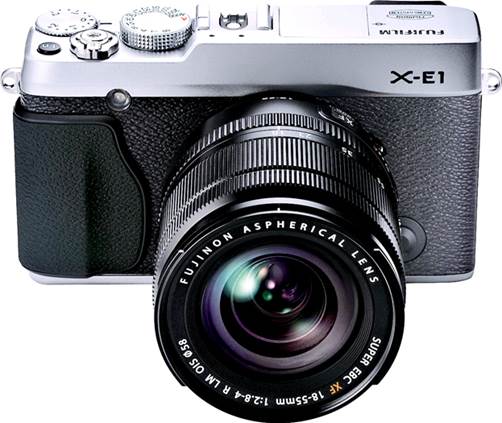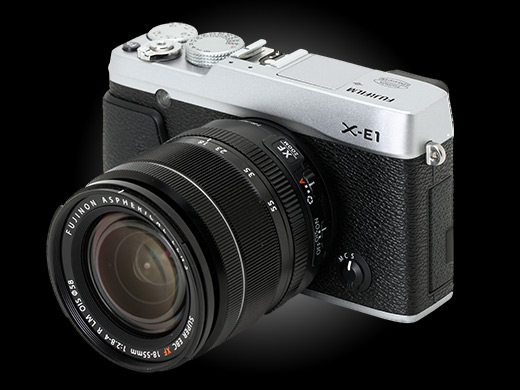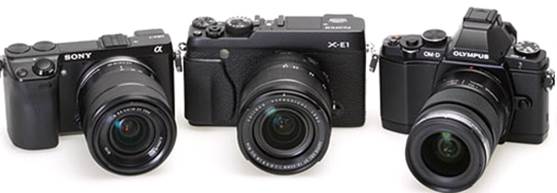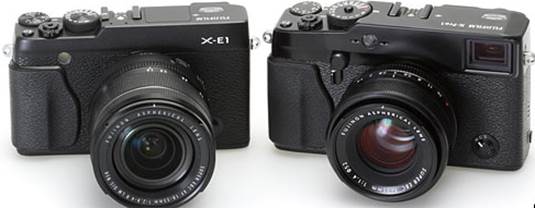Introduction
When Fujifilm released the X system in
January 2012, it did so with an irregular high-end body: X-Pro1. With its
unique hybrid optical/ electronic viewfinder, sturdy metal body and analogue
dial-led control principle, it was clearly targeted at professionals and
enthusiasts who have been looking for an update on the concept of classic
rangefinder. The X-Pro1 has been generally well received, but its high prices
always seem to limit its appeal. Fujifilm X-E1 aims to broaden the scope of
attracting larger enthusiasts, and will confront directly with the reputable
names such as: the Sony Alpha NEX-7 and Olympus OM-D E-M5.

Rating
based on a Fujifilm X-E1 product running software runs 1.04
The
main features
·
16MP X-Trans CMOS sensor
·
ISO 200-6400, 100 - 25600 expanded (JPEG only)
·
2.36M dot OLED electronic viewfinder
·
New kit zoom: 18-55mm F2.8-4R
·
Same control layout as X-Pro1, including
top-plate shutter speed and exposure compensation dials
·
2.8" 460k-dot LCD
·
Integrated pop-up flash
·
Full HD movie recording with integrated stereo
microphone
·
2.5mm stereo microphone socket
·
Compatibility with wired remote control units
(via either the USB port or mic socket)
·
Available in silver or black
The X-E1 is an
essential thinner version of the X-Pro1, with the large, expensive and
complicated hybrid viewfinder that was replaced by a totally-electronic
viewfinder. However, not any old EVF - it uses a part of 2.36M dot OLED that
exceeds the specs of the X-Pro1's 1.44M dot LCD finder. In response, the rear
of its screen is slightly downgraded in terms of size and resolution; it is
still a respectable 2.8" 460k dot LCD – as for Fujifilm, this is necessary
to keep the camera’s size down. The result is a compact body that is equivalent
to the size of the favorite FinePix X100 and its obvious rivals such as E-M5
and NEX-7.
X-E1
- X-Pro1 more reasonable price

The
X-E1 joins a family of the unique cameras which is actually growing apart from
the crowd. The deficiency of the X-E1 is the mixed optical viewfinder found in
the X100 and X-Pro1. From the left to right are the Fujifilm X100, X-E1 and the
X-Pro1.
The X-E1 has a few new functions
corresponding to the X-Pro1, commensurate with its class. There is a small
pop-up flash built in, a 2.5mm stereo microphone jack to record movies, and the
ability to use an electronic shutter release cable besides the signature
threaded shutter release button. But on the other hand it is almost identical
to the X-Pro1, using the same 16MP X-Trans CMOS APS-C sensor and EXR Pro image
processor, and almost the same control layout and interface.

Fujifilm
X-E1
Tweaking firmware – including improved
focusing
Fujifilm does not only work with the new
hardware, it is created a few important tweaks under the hood, which promise
better performance. The good news for those who own the X-Pro1s is that they
will benefit equivalently to this, with the same software version 2
co-published and offered the same updates. The number of recorded files has
been halved, and the camera can log in the playback to check focus and
composition within about two seconds when capturing a single frame. Automatic
ISO allows the use of ISO 6400, but it is sad that there is still no way to
impact the minimum shutter speed. The most significant change, however, is
focusing, both automatic and manual.
The Fujifilm X-E1 uses a new auto focus
algorithm and different sensor driver mode, promising significant speed
improvements, especially with the XF 60mm F2.4 R Macro XF lens or shooting in
low light. In fact, Fujifilm announced the X-E1 and X-Pro1 provide AF speeds
that are competitive with benchmark cameras like the Olympus OM-D E-M5. The “feel”
of the manual focus with electronic driver has been improved, and significantly
the camera sets the wide aperture in manual focus mode, finally allowing really
accurate focusing by EVF. It also has a new 3x zoom level to support manual
focus, which should be less likely to have problems with vibration when using
long lenses.
In general, this makes the X-E1 in terms of
theory a very strong competitor for the mirrorless modes equipped other
high-end EVF. Its traditional control layout means that it should attract the
still-life photographers; although its shooting ability is still lagging behind
its rivals’ (you are able to set the aperture by hand, but unable to control
the shutter speed that the camera uses)
Comparing
design and size

Sony
Alpha NEX-7, X-E1, Olympus OM-D E-M5
This is a size compared between the X-E1
and its most obvious opponents, the Sony Alpha NEX-7 on the left and the
Olympus OM-D E-M5 on the right, all of them are equipped with the corresponding
kit zooms. All functions integrated EVFs and multiple control dials, the NEX-7
and E-M5 both have the rear screens that are able to tilt. The E-M5 also has
image stabilization in the camera body which works with every lens, but on the
other hand lacks an integrated flash.
The kit zoom of the X-E1 offers the same
range of 19-55mm (28-80mm equivalent) as the NEX 7’s, but a faster aperture,
which is good for both low-light shooting and providing a degree of background
blur for portraits. The zoom 12-50mm F3.5-6.3 offers a wider range, a choice of
manual or power zooms for videos, and a useful close-up setting, but at the
cost of aperture maximum.

This
is the X-E1 with its 18-55mm kit zoom, along with its big brother the X-Pro1
equipped with the nice F1.4 R XF 35mm lens. The X-E1 is much smaller because of
removing the optical viewfinder, but the similarity of the two camera series is
generally outstanding.
If you're new to approach digital
photography, you may want to read the Digital Photography Glossary before
submerging in this article (it may help you understand some of the terms used)
Conclusion / Recommendation / Ratings are
based on the reviewer’s thinking; you should read the whole review before
coming to your own conclusions.
Photos which can be viewed at the larger
sizes have a magnifying glass icon located at the bottom right corner of the
image, clicking on the photo will show a larger (typically VGA) size in a new
window.
To orient the review simply use the forward
/ previous buttons, to shift to a specific section you can choose it from the
list below or the navigation bar at the top.
DPReview calibrate the screen by Color
Vision Optical at (well accepted) the PC normal gamma 2.2, which means that on
our monitors we can see the difference between all (generated by computer) the
colors in gray-scale blocks below. We suggest that you should be able to see
the difference (at least) between X, Y and Z and ideally A, B and C to make the
most of this review.